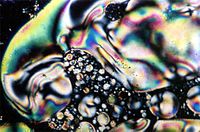
Photo from wikipedia
Accurate measurement of residual dipolar couplings (RDCs) requires an appropriate degree of alignment in order to optimize data quality. An overly weak alignment yields very small anisotropic data that are… Click to show full abstract
Accurate measurement of residual dipolar couplings (RDCs) requires an appropriate degree of alignment in order to optimize data quality. An overly weak alignment yields very small anisotropic data that are susceptible to measurement errors, whereas an overly strong alignment introduces extensive anisotropic effects that severely degrade spectral quality. The ideal alignment amplitude also depends on the specific pulse sequence used for the coupling measurement. In this work, we introduce a practical strategy for the accurate measurement of one-bond 13C-1H RDCs up to a range of ca. -300 to +300 Hz, corresponding to an alignment that is an order of magnitude stronger than typically employed for small molecule structural elucidation. This strong alignment was generated in the mesophase of the commercially available poly-γ-(benzyl-L-glutamate) polymer. The total coupling was measured by the simple and well-studied heteronuclear two-dimensional J-resolved experiment, which performs well in the presence of strong anisotropic effects. In order to unequivocally determine the sign of the total coupling and resolve ambiguities in assigning total couplings in the CH2 group, coupling measurements were conducted at an isotropic condition plus two anisotropic conditions of different alignment amplitudes. Most RDCs could be readily extracted from these measurements whereas more complicated spectral effects resulting from strong homonuclear coupling could be interpreted either theoretically or by simulation. Importantly, measurement of these very large RDCs actually offers significantly improved data quality and utility for the structure determination of small organic molecules.
Journal Title: Journal of magnetic resonance
Year Published: 2018
Link to full text (if available)
Share on Social Media: Sign Up to like & get
recommendations!